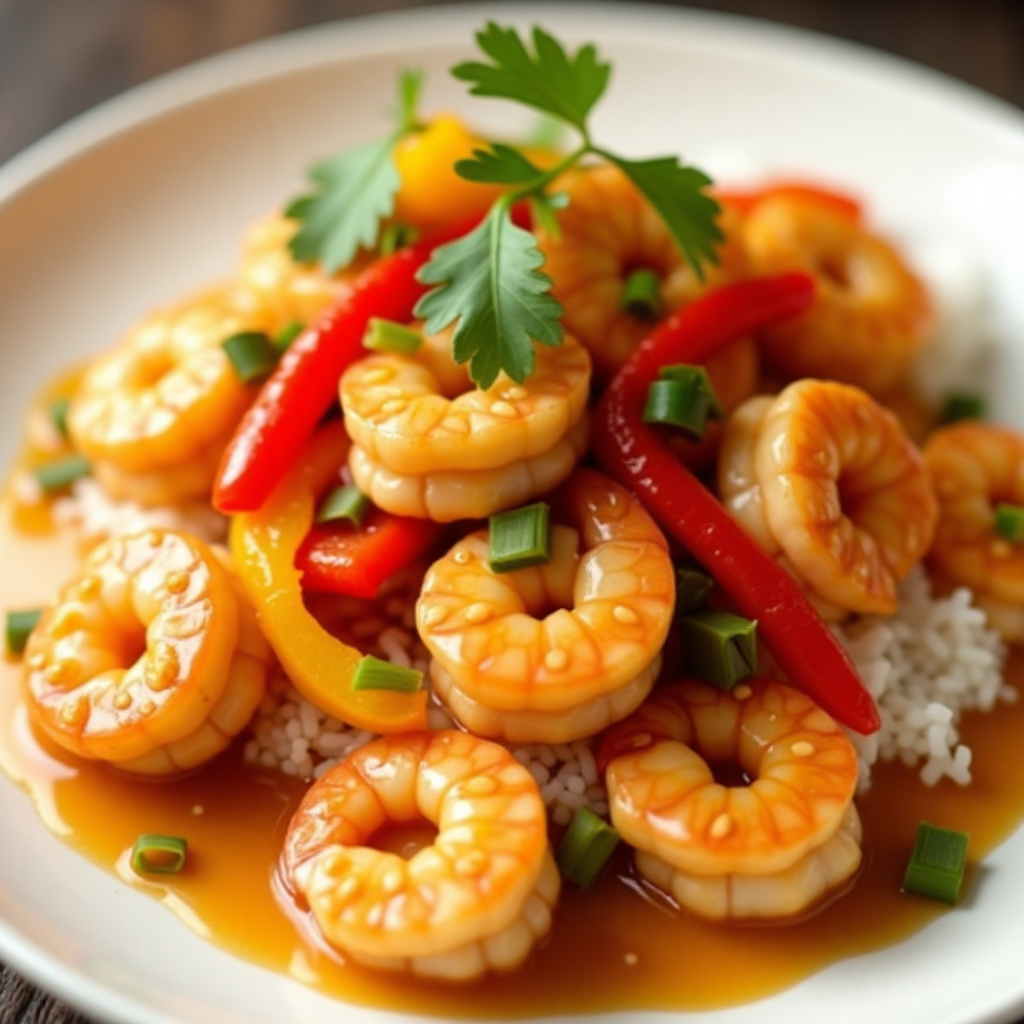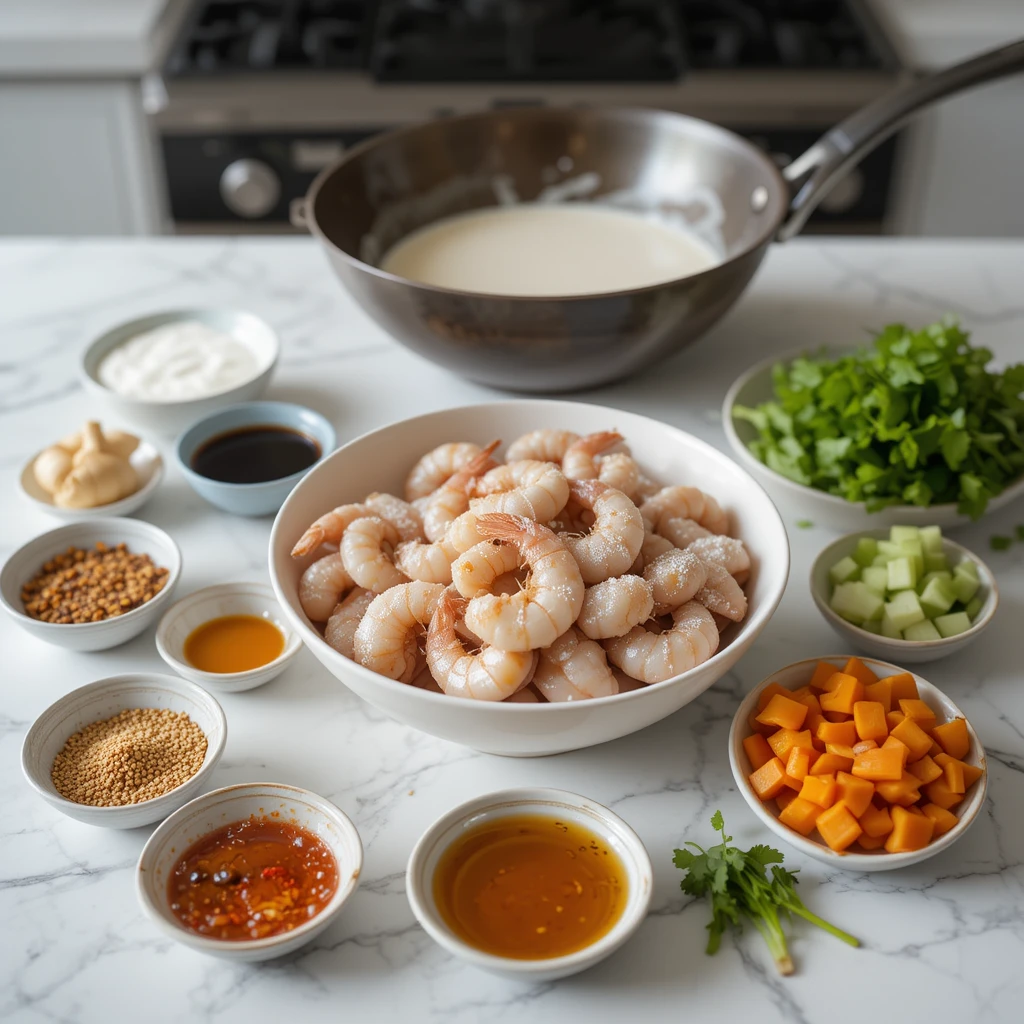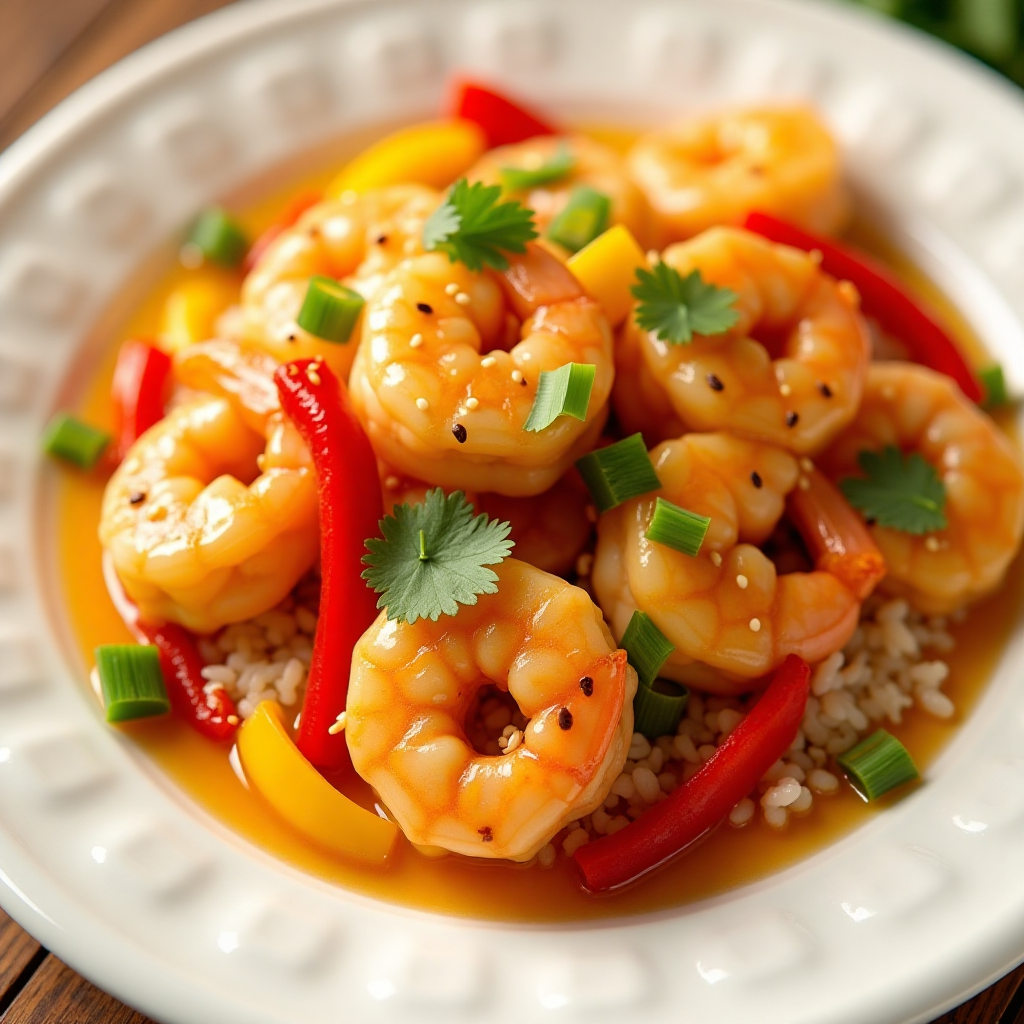Creamy Chinese Coconut Shrimp Recipe
Picture this: succulent shrimp swimming in a velvety coconut sauce that’s both sweet and savory, with just the right hint of Asian spices. This creamy chinese coconut shrimp transforms your ordinary weeknight dinner into something extraordinary!
Fun fact: coconut-based seafood dishes have been cherished in coastal Chinese cuisine for centuries, where fresh coconut milk was readily available. What makes this recipe truly special is its incredible simplicity – you can create restaurant-quality flavors in just 20 minutes using ingredients you likely already have.
Unlike our popular Honey Garlic Shrimp that takes 30 minutes, this dish comes together even faster while delivering that luxurious, creamy texture everyone craves. Get ready to impress your family and friends with minimal effort!
Table of Contents
What is Chinese Coconut Shrimp?

Ever wondered why we call it chinese coconut shrimp when coconuts aren’t exactly native to northern China? Well, here’s the delicious truth: this fusion creation combines the best of Chinese stir-fry techniques with the tropical richness of coconut milk, creating a harmony that’s absolutely irresistible!
The name might sound fancy, but don’t let that intimidate you – it’s simply shrimp cooked in a luscious coconut-based sauce with Asian-inspired seasonings. Legend has it that this dish gained popularity in Chinese-American restaurants where creative chefs experimented with local ingredients.
As they say, “the way to a man’s heart is through his stomach,” and this creamy, aromatic dish certainly proves that point! Ready to discover why this fusion favorite has won hearts worldwide? Let’s dive into this culinary adventure together!
Why You’ll Love This Chinese Coconut Shrimp:
The star of this show is undoubtedly the silky, aromatic coconut sauce that coats each plump shrimp with layers of flavor. Imagine the sweet richness of coconut milk dancing with savory soy sauce, fresh ginger, and a whisper of garlic – it’s pure magic in every bite!
Making this chinese coconut shrimp at home saves you serious money compared to ordering from your favorite Asian restaurant, plus you control the quality of ingredients and spice level. The beauty lies in the simple yet flavorful combination: tender shrimp, creamy coconut milk, fragrant aromatics, and colorful bell peppers that add both crunch and visual appeal.
Unlike our Spicy Szechuan Shrimp that packs serious heat, this version offers gentle warmth that’s perfect for the whole family. The sauce is so incredibly good, you’ll want to drizzle it over rice, noodles, or even vegetables! Ready to bring this restaurant favorite to your own kitchen? Let’s get cooking!
How to Make Chinese Coconut Shrimp:
Quick Overview
This chinese coconut shrimp recipe is a true weeknight warrior – simple enough for beginners yet impressive enough for entertaining! What makes it absolutely irresistible is the creamy coconut sauce that’s both comforting and exotic, with tender shrimp that practically melt in your mouth.
The magic happens in just one pan, where everything comes together in perfect harmony. Best of all, you’ll have this restaurant-quality dish ready in just 20 minutes from start to finish, making it ideal for those busy evenings when you want something special without the fuss.
Key Ingredients for Chinese Coconut Shrimp:
For the Shrimp:
- 1.5 lbs large raw shrimp, peeled and deveined
- 1 tablespoon cornstarch
- 1/2 teaspoon salt
- 1/4 teaspoon white pepper
For the Coconut Sauce:
- 1 can (14 oz) full-fat coconut milk
- 2 tablespoons soy sauce
- 1 tablespoon oyster sauce
- 1 teaspoon sesame oil
- 1 tablespoon brown sugar
- 1 tablespoon rice vinegar
Aromatics and Vegetables:
- 3 cloves garlic, minced
- 1 tablespoon fresh ginger, grated
- 1 red bell pepper, sliced
- 1 yellow bell pepper, sliced
- 3 green onions, chopped
- 2 tablespoons vegetable oil
- 1 tablespoon toasted sesame seeds (for garnish)
- Fresh cilantro for garnish

Step-by-Step Instructions:
Step 1: Prepare the Shrimp Pat the shrimp completely dry with paper towels. In a medium bowl, toss the shrimp with cornstarch, salt, and white pepper until evenly coated. This coating helps create a slightly crispy exterior and prevents the shrimp from becoming rubbery. Let the seasoned shrimp sit for 5 minutes while you prepare the sauce and vegetables.
Step 2: Make the Coconut Sauce In a small bowl, whisk together the coconut milk, soy sauce, oyster sauce, sesame oil, brown sugar, and rice vinegar until smooth. Make sure to stir the coconut milk well before measuring, as it often separates in the can. Set this sauce mixture aside – you’ll add it to the pan later.
Step 3: Cook the Aromatics Heat vegetable oil in a large skillet or wok over medium-high heat. Add the minced garlic and grated ginger, stirring constantly for about 30 seconds until fragrant. Be careful not to burn them, as this can make the dish bitter.
Step 4: Add Vegetables Add the sliced bell peppers to the pan and stir-fry for 2-3 minutes until they’re bright and slightly tender but still crisp. The peppers should maintain their vibrant color and have a slight bite to them.
Step 5: Cook the Shrimp Push the vegetables to one side of the pan and add the seasoned shrimp. Cook for 2 minutes on one side without moving them, then flip and cook for another 1-2 minutes until they turn pink and are almost cooked through. Don’t overcook the shrimp at this stage, as they’ll continue cooking in the sauce.
Step 6: Add the Coconut Sauce Pour the prepared coconut sauce over the shrimp and vegetables. Bring the mixture to a gentle simmer, then reduce heat to medium-low. Let it simmer for 3-4 minutes, stirring occasionally, until the sauce thickens slightly and the shrimp are fully cooked and coated in the creamy sauce.
Step 7: Final Touches Remove from heat and stir in half of the chopped green onions. Taste and adjust seasoning if needed – you might want a pinch more salt or a squeeze of lime juice for brightness. Garnish with remaining green onions, toasted sesame seeds, and fresh cilantro before serving immediately.
What to Serve Chinese Coconut Shrimp With:

This creamy chinese coconut shrimp pairs beautifully with steamed jasmine rice or fluffy coconut rice, which soaks up every drop of that luscious sauce. For a low-carb option, serve it over cauliflower rice or zucchini noodles. Crispy chow mein noodles add wonderful texture contrast, while steamed broccoli or snap peas provide fresh, green balance to the rich coconut flavors.
For drinks, try jasmine tea, coconut water. A simple cucumber salad with rice vinegar dressing makes an excellent palate cleanser between bites.
Top Tips for Perfecting Chinese Coconut Shrimp:
Use Full-Fat Coconut Milk: Light coconut milk won’t give you that rich, creamy texture that makes this dish special. Always shake the can before opening and stir well if separated.
Don’t Overcook the Shrimp: Shrimp cook incredibly quickly – they’re done when they turn pink and curl slightly. Overcooked shrimp become tough and rubbery, so watch them carefully.
Prep Everything First: This dish moves fast once you start cooking, so have all ingredients chopped, measured, and ready to go before you heat the pan.
Control the Heat: Keep the heat at medium-high for searing the shrimp, then reduce to medium-low when adding the sauce to prevent curdling the coconut milk.
Ingredient Substitutions: Can’t find oyster sauce? Use an extra tablespoon of soy sauce plus a teaspoon of brown sugar. No sesame oil? A drizzle of toasted sesame seeds at the end adds similar nutty flavor.
Make it Spicier: Add a sliced Thai chili or a pinch of red pepper flakes with the garlic and ginger for those who like heat.
Storing and Reheating Tips:
Store leftover chinese coconut shrimp in an airtight container in the refrigerator for up to 3 days. The coconut sauce may thicken considerably when cold, which is completely normal. To reheat, place in a skillet over medium-low heat and add a splash of coconut milk or chicken broth to loosen the sauce. Stir gently and heat until warmed through, about 3-4 minutes.
For freezing, this dish keeps well for up to 2 months when stored in freezer-safe containers. Thaw overnight in the refrigerator before reheating. When reheating from frozen, let it thaw completely first, then follow the same reheating instructions as above.
Avoid microwaving if possible, as it can make the shrimp rubbery and cause the coconut sauce to separate. If you must use the microwave, reheat in 30-second intervals on 50% power, stirring between each interval. The key is gentle, even heating to maintain that silky sauce texture and tender shrimp that makes this dish so irresistible!
Nutritional Benefits of Chinese Coconut Shrimp:
This chinese coconut shrimp isn’t just delicious – it’s surprisingly nutritious too! Shrimp are an excellent source of lean protein, providing about 25 grams per serving while being naturally low in calories and carbs. They’re packed with selenium, which supports immune function, and contain omega-3 fatty acids for heart health.
Coconut milk provides healthy medium-chain triglycerides (MCTs) that can boost metabolism and provide quick energy. The colorful bell peppers add vitamin C, antioxidants, and fiber, while ginger offers anti-inflammatory properties and digestive benefits.
This dish provides a balanced macro profile that fits well into various dietary approaches, from keto to Mediterranean-style eating.
Recipe Variations and Dietary Adaptations:
| Dietary Need | Modification | Notes |
|---|---|---|
| Keto/Low-Carb | Serve over cauliflower rice or zucchini noodles | Keeps carbs under 10g per serving |
| Dairy-Free | Recipe is naturally dairy-free | Perfect for lactose intolerance |
| Gluten-Free | Use tamari instead of soy sauce | Ensure oyster sauce is gluten-free certified |
| Paleo | Replace soy and oyster sauce with coconut aminos | Maintains the umami flavor profile |
| Vegetarian | Substitute firm tofu or cauliflower for shrimp | Press tofu well and cut into chunks |
| Spicy Version | Add 1-2 Thai chilies or sriracha to taste | Adjust heat level gradually |
| Extra Protein | Add cashews or edamame | Increases protein and adds texture |
| Lower Sodium | Use low-sodium soy sauce and skip added salt | Reduce sodium by up to 40% |
Ingredient Sourcing and Quality Tips:
Choosing quality ingredients makes a significant difference in your chinese coconut shrimp final flavor. For shrimp, opt for wild-caught when possible – they have better texture and flavor than farm-raised varieties. Fresh shrimp should smell like the ocean, not fishy, and feel firm to the touch. If using frozen shrimp, choose those without added sodium solutions.
For coconut milk, Thai brands like Chaokoh or Mae Ploy offer the richest, most authentic flavor compared to lighter Western brands. Always buy full-fat versions for the creamiest results. When selecting bell peppers, choose ones with glossy, unwrinkled skin and firm flesh. Store fresh ginger in the freezer – it grates easier when frozen and lasts much longer!
Budget-Friendly Shopping Tips:
Making restaurant-quality chinese coconut shrimp at home can save you up to 70% compared to takeout costs! Buy shrimp in bulk when on sale and freeze in meal-sized portions. Generic coconut milk works perfectly fine and costs about half the price of premium brands.
Purchase bell peppers when they’re in season (summer months) or buy frozen pepper strips for year-round affordability. Asian grocery stores often sell soy sauce, oyster sauce, and sesame oil at significantly lower prices than regular supermarkets. A single batch of this recipe serves 4-6 people and costs approximately $12-15 to make, compared to $40-50 for equivalent restaurant portions.
Meal Prep and Batch Cooking Strategies:
This chinese coconut shrimp is excellent for meal prep! Cook a double batch on Sunday and portion into containers with rice for grab-and-go lunches all week.
The flavors actually improve after sitting overnight as the coconut sauce melds with the other ingredients. For batch cooking, prepare the sauce components in advance and store in the refrigerator for up to a week.
You can also prep and season the shrimp, storing them covered in the fridge for up to 24 hours before cooking. Consider making coconut sauce ice cubes – freeze the prepared sauce in ice cube trays, then pop them into freezer bags. This way, you can make single servings anytime by simply cooking fresh shrimp and adding the frozen sauce cubes!
Frequently Asked Questions About Chinese Coconut Shrimp:
Can I use frozen shrimp for this recipe?
Absolutely! Frozen shrimp work perfectly for chinese coconut shrimp. Just make sure to thaw them completely and pat them very dry before seasoning. Remove them from the freezer the night before and place in the refrigerator, or for quick thawing, place in a bowl of cold water for 15-20 minutes. Never use warm water as it can partially cook the shrimp and affect their texture.
What’s the best substitute for coconut milk?
While coconut milk is essential for authentic flavor, you can use cashew cream (soaked cashews blended with water) or heavy cream mixed with a tablespoon of coconut extract in a pinch. However, these substitutes won’t provide the same tropical sweetness and richness that makes this dish special. Light coconut milk can work but will result in a thinner sauce.
How do I prevent the coconut milk from curdling?
Keep your heat at medium-low when adding the coconut sauce and avoid rapid temperature changes. Don’t add the sauce to a screaming hot pan – let it cool slightly first. If your coconut milk does separate, simply whisk it gently back together. Using full-fat coconut milk and avoiding high heat are your best defenses against curdling.
Can I make this dish ahead of time?
You can prepare all the components ahead of time, but it’s best to cook the shrimp fresh for optimal texture. The sauce can be made up to 3 days in advance and stored in the refrigerator. The vegetables can be chopped and the shrimp can be seasoned a day ahead. However, once fully cooked, the dish is best enjoyed immediately, though leftovers reheat well.
What size shrimp should I use?
Large shrimp (21-25 count per pound) or extra-large (16-20 count) work best for this chinese coconut shrimp recipe. They’re substantial enough to hold up to the sauce without overcooking and provide satisfying bites. Avoid small shrimp as they can become rubbery quickly and don’t pair well with the rich coconut sauce.
Is this recipe naturally gluten-free?
The recipe contains soy sauce and oyster sauce, which typically contain gluten. To make it gluten-free, substitute tamari for soy sauce and use a certified gluten-free oyster sauce, or replace it with an additional tablespoon of tamari plus a teaspoon of brown sugar for sweetness.
